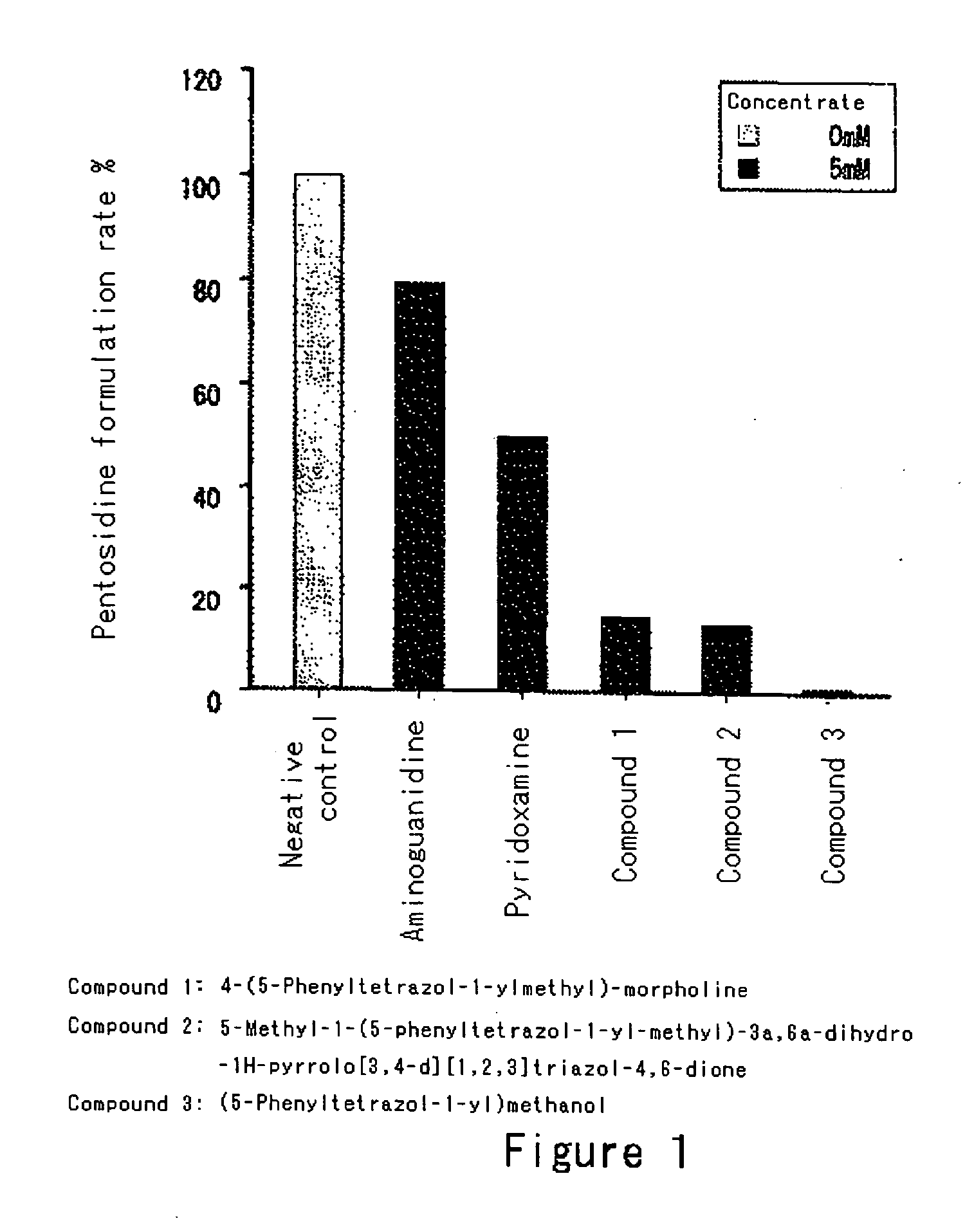Modified-protein formation inhibitor
a technology of protein modification and inhibitor, which is applied in the field of inhibitors of protein modification products, can solve the problems of restricted use of these products, and achieve the effect of good sorbability
- Summary
- Abstract
- Description
- Claims
- Application Information
AI Technical Summary
Benefits of technology
Problems solved by technology
Method used
Image
Examples
preparation example 1
Preparation of 4-(5-phenyltetrazol-1-ylmethyl)-morpholine (Compound 1)
[0164] To a solution of 26.0 g (0.18 mol) of 5-phenyltetrazole in 270 ml of methanol, were added 17.0 g (0.2 mol) of morpholine and 17.8 g of 36% formalin at 5° C., followed by stirring at room temperature overnight. To the reaction mixture, hexane (200 ml) was added, and the precipitated crystals were collected by filtration. The collected crystals were dried in vacuum to give 4-(5-phenyltetrazol-1-ylmethyl)-morpholine (43.6 g; yield, 99%) as white crystals. The structure was confirmed by nuclear magnetic resonance spectrum (N MR) and mass spectrum (Mass)
[0165] NMR: significant signals 2.714 ppm t 4H morpholine CH2 3.709 ppm t 4H morpholine CH2 5.499 ppm s 2H CH2 between tetrazole and morpholine 7.494 ppm m 3H phenyl CH 8.171 ppm m 2H phenyl CH
[0166] Mass(EI-MS): m / z 245 (molecular weight)
[0167] In the same manner, 5-methyl-1-(5-phenyltetrazol-1-ylmethyl)-3a,6a-dihydro-1H-pyrrolo[3,4-d][1,2,3]triazole-4,6-dio...
preparation example 2
Preparation of 1-(5-phenyltetrazol-1-ylmethyl)-piperazine (Compound 4)
[0168] 5-Phenyltetrazole (2.00 g; 13.8 mmol) was dissolved in 20 ml of methanol, and 2.37 g (27.6 mmol) of piperazine and 1.342 g (16.54 mmol) of 36% formalin were added thereto, followed by stirring at a temperature below 10° C. and warming to room temperature. This mixture was stirred overnight and reacted. The objective compound formed with the progress of the reaction was precipitated as crystals, because of its highly poor solubility. After completion of the reaction, the precipitated crystals were collected by filtration and dried in a desiccator in vacuum to give 0.959 g of 1-(5-phenyltetrazol-1-ylmethyl)-piperazine as white crystals.
preparation example 3
Preparation of 1-methyl-4-(5-phenyltetrazol-1-ylmethyl)-piperazine (Compound 5)
[0169] 5-Phenyltetrazole (13.0 g; 89.6 mmol) was added in 113 ml of methanol and cooled, and 9.82 g (98.0 mmol) of methylpiperazine and 9.2 g (0.11 mol) of 36% formalin were added thereto, followed by stirring. The mixture was then stirred at room temperature overnight to react. After removal of methanol by distillation, the residue was suspended in water, and the precipitated crystals were collected by filtration. The collected crystals were washed with water and dried to obtain 13.0 g (yield 56.2%) of 1-methyl-4-(5-phenyltetrazol-1-ylmethyl)-piperazine as beige crystals.
[0170] The structure of 1-methyl-4-(5-phenyltetrazol-1-ylmethyl)-piperazine was confirmed by nuclear magnetic resonance spectrum (NMR). The result supported that the structure of the objective compound. The data is as shown below.
[0171] NMR: significant signal 2.258 ppm s 3H CH3 2.455 ppm t 4H piperazine CH2 3.761 ppm t 4H piperazine ...
PUM
| Property | Measurement | Unit |
|---|---|---|
| molecular weight | aaaaa | aaaaa |
| pore diameter | aaaaa | aaaaa |
| temperature | aaaaa | aaaaa |
Abstract
Description
Claims
Application Information
 Login to View More
Login to View More - R&D
- Intellectual Property
- Life Sciences
- Materials
- Tech Scout
- Unparalleled Data Quality
- Higher Quality Content
- 60% Fewer Hallucinations
Browse by: Latest US Patents, China's latest patents, Technical Efficacy Thesaurus, Application Domain, Technology Topic, Popular Technical Reports.
© 2025 PatSnap. All rights reserved.Legal|Privacy policy|Modern Slavery Act Transparency Statement|Sitemap|About US| Contact US: help@patsnap.com



